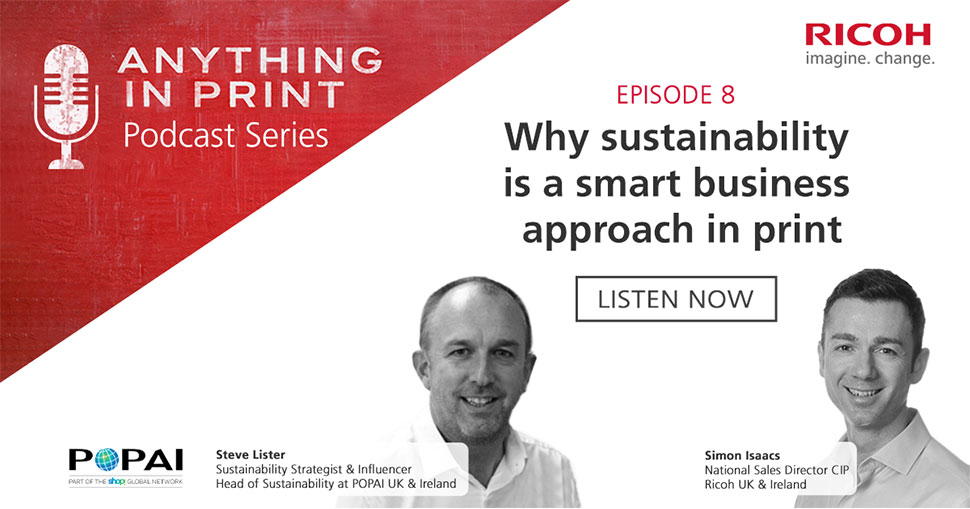Simon Isaacs, National Sales Director at Ricoh UK, was joined by sustainability strategist and influencer Steve Lister to discuss some of the key advantages of going sustainable in print and how taking these steps could help set your business up for growth in the long term.
With sustainability now a huge topic that continues to gain momentum, and an increasing number of consumers opting for brands that have environmental concerns at heart, there is simply no getting away from its importance when it comes to print production.
Key highlights from the podcast include:
Print must continue to evolve to adapt to a changing market landscape
Having worked on print campaigns with leading retailers and brands for more than 15 years, Steve Lister has seen a great deal of change when it comes to the issue of sustainability, with this having accelerated during the pandemic as attitudes towards shopping continue to evolve.
In his role with POPAI, the association that works to encourage best practice in the point-of-purchase sector, Steve Lister works with the likes of Lego, Kellogg’s, P&G and Unilever, witnessing first-hand the changing attitudes towards sustainability and how this filters down to print.
As such, print companies have little choice but to evolve themselves or risk being left behind as more green-minded competitors take sustainable steps in order to satisfy customer demand for more environmentally friendly print.
“There are still lots of people who don’t care about sustainability, but this is an increasing minority,” Steve Lister explains. “We all have our own role to play when it comes to protecting the environment. If you are a printer, you have got to be more sustainable; think about how you are printing work, are you creating lots of waste, and what can you do to reduce environmental impact when delivering products.”
How to establish your own print sustainability strategy
Steve Lister accepts that times are tough for print companies, given the issues caused by the pandemic and the ongoing cloud of uncertainty that continues to linger over the industry. However, when it comes to communicating your sustainable message to customers, there are several initial steps to take to ensure your green light shines bright.
- Make sure your employees understand your focus on sustainability so that they can take pride in working for a company that cares about the environment. This is particularly true for the next generation workers, who will be more conscious about the environment than ever, having grown up with processes such as recycling being the norm.
- You should look to using the right sort of technologies and processes that will fit in with your sustainability strategy. This could mean switching to latex inks when printing products, investing in more environmentally friendly hardware such as a flatbed printer, or working with materials sourced from responsible sources.
- Consider how printed products reach the customer. Is there anything you can do to reduce your impact on the environment when delivering print or when taking delivery of consumables and other materials required to produce printed work?
The importance of telling your company’s own sustainable story
Even after taking these steps and becoming a more sustainable print operation, much of this will go to waste if you do not communicate your achievements and hard work to clients and customers.
“It’s just simply telling a story,” Steve Lister said. “Why would you not tell your story all the way through? We grew up hearing stories, and as we grow up, we stop telling these stories. If I was in a print business, I would make sure I know where my substrates come from and the type of technology I use.
“You build up a beautiful story, which means you can charge more for it as there is so much more value in this.”
Steve Lister went on to give the example of cosmetics retailer Lush, which actively promotes how it uses recycled containers from its products to create signage for around its stores. He said print companies need to take a leaf out of this book and do the same with their own work to create greater value, which customers will then take note of and appreciate.
Analysing the impact of Covid-19 on changing sustainability trends and demands
While the pandemic has had a negative impact on some aspects of print, there have been some silver linings to the cloud that has covered the industry for the best part of 18 months, including sustainability.
Major retailer Next has been using a Ricoh printer to produce signage directing staff how to recycle certain materials such as packaging waste. By taking this simple step, Next has been able to reduce its impact on the environment, even at a time of high financial pressure.
“If you are going to offer sustainable solutions, then your company has to deliver and have systems in place,” Steve Lister said. “Companies have to step up and create a sustainable strategy, as well as have a stepped approach to create this.”
Be enthusiastic about your sustainable goals and achievements
Steve Lister encourages print companies to do all they can to shout about their sustainable achievements, explaining that by doing so, consumers will sit up and take notice, which will in turn lead to higher sales and business growth.
“Print is an incredible way of getting your message across to all people,” he said. “It’s just changing and evolving. We will continue to print, find new ways to do it and make it more sustainable, after which it is about having the passion to take new things to your clients and inspire them to take similar steps.
“It has been tough, but now is the chance to reinvent yourself and become more innovative. Take your ideas and innovations to clients, engage them, reignite yourselves and get print back in the hands of brands, retailers and consumers.
“Be enthusiastic, take this out and grow your business.”
To listen to the full podcast episode, please click here
To find out more about Ricoh’s own approach to sustainability, click here



